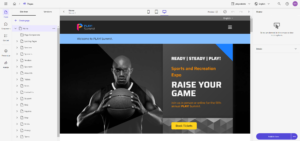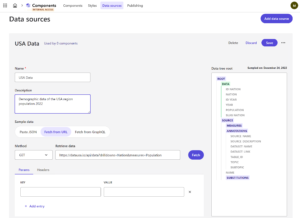If you ask anyone in the Sitecore community what was the biggest hype of 2022 – there wouldn’t be any other opinion than mentioning XM Cloud. Let’s take a look at this latest and shiny SaaS offering!
Content
- Part 1: Overview, Architecture, Features
- Part 2: New Tools and Interfaces
- Part 3: Development with XM Cloud
Old good Content Editor and Experience Editor still remain with us and that’s good news for those who habitually stick to the interfaces. they used to. Nevertheless, this blog post will familiarize you with the totally new apps and interfaces coming with XM Cloud.
Sites
This application opens by default. It shows up all of the websites available in the system with the predictive typing search bar to filter them out. Clicking any of the sites opens them up in a Pages app, as expected.
What is more interesting is the ability to create websites directly from this interface by clicking the “Create website” button.

Pages
If you played around Horizon in the latest versions of XP such as 10.2, you will immediately recognize this user interface. Pages are built on the foundation of Horizon:

The Pages application has 5 views which you select from the left navigation stripe:
- Pages
- Components
- Content
- Personalize
- Analyze
I personally find it a little confusing, that some views have the same names and apps. For example, by clicking the Components view of the above Pages app from the left bar navigation, you will see a component selector which you can drag and drop to the editable page. However, this is totally different from the Components application which is a turbocharged tool for creating components to be used on a page, which you later choose by the mentioned component selector of Pages application.
I want to highlight that Pages was done with attention to minor details. It has very pleasant animation effects for many transitions, leaving you with a premium experience feelings. There is no “Save” button anywhere as Pages application autosaves your changes.
It also has support for multiple websites selected from a dropdown. Preview, Devices Experience, Navigation Tree – all these features are located at the same interface you would expect in order to have a productive editing experience.
Components
The tool is still in its early stages, but it has a lot of potentials. Its purpose is to enable content creators and marketers to create components without the need for a developer to start from scratch.
There are lots of styling options to specify custom types, and custom fonts, at least it looks advanced.
Here we create the component and publish it, so that component becomes available in the component library of the Pages app. The intention is for us to be able to put components together and create them together from basic page elements, images, links, and so forth. Starting with a grid, then you simply start adding columns, set alignment, and apply other UI-related things.
But what is the most impressive feature of Components app is – we not only create and customize individual components similar to the way we do it in SXA, but now we create entire components completely from scratch, we can style them and can hydrate them with data from an external data source. By saying external I mean really external: one of many 3rd party content providers and headless CMSs, like Content Hub One, Contentful, Kontent.ai, etc., and all that with zero code!
All you need to do is to provide an API endpoint and use a mouse to select what fields from the source you want to map. For those who are behind a tough firewall or strict corporate policies, there is an option to directly paste in a sample JSON snippet to map against it. They don’t ever have to hit the live API when creating a datasource.
What is even more mind-breaking is that you can feed the same single component from various external systems at the same time. Image a Promo Block component that you can easily drag and drop to a page that consists of:
- Heading title that sits natively at Sitecore XM Cloud
- Image taken from Content Hub DAM
- Localized promo content taken from Contentful CMS
- Call to action button that is wired up to CDP
In my opinion, that is a superpower of XM Cloud editing capabilities! I very much recommend watching this short video demonstrating the whole power of the new Components app.

How the data is updated and invalidated with Components? It seems that the data is pulled in at the moment when the connection is established, and not get refreshed at the moment of publication.
Personalize
A cut version of Sitecore Personalize comes built into Pages interface of XM Cloud to allow for basic view event personalization. Therefore there isn’t a one-to-one match of old XP rulesets to the new ones, so a deeper analysis and re-evaluation of your personalization strategy is needed.
With XM Cloud there’s a new way of doing personalization coming out of the box: we have a limited set of rules available to us and those are primarily rules based on the current session, such as day of the week, a visitor’s country, to an operating system of visitor’s current device. However, there’s no way you can manage the built-in Personalize tenant directly from the XM Cloud interface.
Checking carefully, you can still find some rules based on historical data: an example of a history-based rule is the number of page views a visitor has visited pages within the past (max) 30 days. Of course, once you enable full Sitecore Personalize a set of tools will expand the functionality to a wider range of options.
Unlike XP where we would personalize each component individually, in XM cloud we create page variants to achieve that so that we can define the audience that will be exposed to that page variant.
Configuring the audience, you see the default set of rules, I counted 14:
- Point of sale: The visit is to point(s) of sale
- Region: The visitor is in region(s) during the current visit
- Country: The visitor is in country(s) during the current visit
- Visit day of the month: The visit is on a day of the month that compares to number based on your organization’s time zone
- Day of the week: The visit is on a day(s) of the week, based on your organization’s time zone
- Month of visit: The visit is in month(s), based on your organization’s time zone
- First referrer: The visitor comes from a URL that compares to referrer in the current visit
- UTM value: The visit includes a UTM type that compares to UTM value
- Operating system: The visitor is using operating system(s) during the current visit
- Device: The visitor is using a device type(s) device during the current visit
- Number of page views: The visitor has visited page within the past x days and the total number of page views compares to a number of views
- First page: The visit has started on a page that compares to page during the current visit
- Page view: The visitor has visited page name(s) during the current visit
- New or returning visitor: The visitor is a specific type to your site
After specifying the audience, you then process customizing components for that page variant.
That is implemented in a very similar manner as it was back in the XP: specify the data source item with the desired content, choose a different component to replace the default one, or simply choose to hide the component as another option.

The bigger question comes about how personalization works with Edge, without having CD servers previously responsible for executing personalization. It is important to understand that the personalization logic is now happening at the Vercel/Next.js middleware level.
A middleware package intercept browser request at Vercel in order to do audience matching with Personalize, and then serves the relevant content from the Edge, for example by substituting personalized Edge content from one to another. The above approach does not imply any performance penalties at all since all the parts of this chain are super-fast at CDN/Jamstack level at Vercel and also because the content is already cached at Experience Edge. I would recommend spending some time reading through more details about the built-in personalization in XM Cloud by this link.
Analyze
Another excellent embedded tool powered by Boxever page-level analytics: pages built-in with Pages have embedded tracking tag therefore analytics become auto-available. Just out of the box it will empower you to see:
- the browsers the operating system
- the source where they came from
- the pages: first page, entry page, top pages
- visited top countries
- by source visits
- by time of the day
Analytics presents data with a heat map for the time of the day with most traffic shown by darker rectangles.

Similar to the previous example of Personalize, this analytics system is now built on top of the Sitecore CDP. Previously all the analytics was taken out from Sitecore XDB, and without having that in SaaS cloud offerings the only option for providing built-in analytics and personalization was to rely on CDP and Personalize in some way.
Explorer
In addition to Pages you can use Explorer for editing content. I think the main idea of this interface was to give editors the ability to switch rapidly between visual and filled editing interfaces.
Explorer presents you the content with some similarity to Horizon performing on XP: kind of a Content Editor with navigation and the ability to publish and edit items at the fields level. You can do many expected content operations here like modify, copy, upload download media assets etc.
Interestingly that Sitecore decided to walk away from a tree-based style of presenting content structure to a drill-into way of navigation. It definitely makes things clear, and when we need to take a look at the entire structure of the content tree – there is still old good Content Editor to our help.

Site identifier
This is an interface to add a tracker to your websites if they are missing so that they become trackable with Analyze section of Pages app.

That was an overview of the most important new applications and interfaces coming with XM Cloud. The next post in this series will take you through the development experience with XM Cloud.

